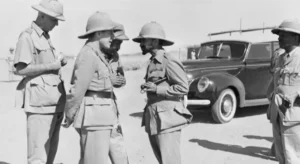Published with the Permission of Defense & Foreign Affairs Special Analysis Journal
 British advisor Orde Wingate with Emperor Haile Selassie in Ethiopia, 1941.
British advisor Orde Wingate with Emperor Haile Selassie in Ethiopia, 1941.
Waiting for Another Historical Parting on the Red Sea
Analysis. By Gregory R. Copley, Editor, GIS/Defense & Foreign Affairs.
Little or no news or intelligence of any substance has emerged in the public arena from the fighting inside Ethiopia in recent months, but the war is now almost certainly the biggest in the world, in terms of casualties.
Some 1.5-million lives are reported to have been lost in the past year of the Government’s attempt to destroy the Amhara, Afar, and other peoples. And some 26-million Ethiopians are now internally displaced persons (IDPs).
But it looks as though the major casualty may be Prime Minister Abiy Ahmed Ali and his Government. Significantly, the People’s Republic of China (PRC) has staked much on its support for Dr Abiy, especially given how important Ethiopia is, geographically, to protecting or threatening the PRC’s only naval base on the Red Sea, in Djibouti.
In infrastructure terms, the wars in Ukraine and Israel-Gaza are where the most damage has been done. But the wars in Ethiopia and the eastern part of the Democratic Republic of Congo (DRC), which is now entering its election phase, are causing the greatest human casualty levels.
It should be stressed that the current conflict — civil war — in Ethiopia is not directly related to the earlier civil war in which the former Government of the extreme marxist Tigré (Tigray) Popular Liberation Front (TPLF) fought to regain control of the country. That ended on November 2, 2022, with an Agreement for Lasting Peace through a Permanent Cessation of Hostilities between the Ethiopian Government and the TPLF. And even though the promised relief of Tigrean displaced persons has not been fulfilled, a number of former TPLF military personnel were re-absorbed into the Ethiopian National Defense Force (ENDF).
The Abiy Government in that conflict had partnered with the Amhara population, which had been significantly attacked by the TPLF. And, with the TPLF silenced, the Abiy Government turned its attention on the Amhara and Afar people, as well as on the many Ethiopians who declare their support for a unified nation by their support for the Ethiopian Tewahedo Orthodox (Christian) Church. Then, as now, Abiy has cut Ethiopia off from most internet links.
The Amhara strenuously resisted the Abiy attempts to invade and neutralize the historically significant position which the Amhara region and people have had in Ethiopia. [The Amhara are the second largest population among the 80 or so ethnic groups of Ethiopia, after the Oromo people, with whom Dr Abiy identifies.] The Amhara then developed a militia movement — known as Fano — to resist the unprovoked attempts by Abiy to reduce the capabilities of the Amhara. What happened then, earlier in 2023, was that ENDF forces found themselves told to target innocent villages to eliminate the inhabitants. Many ENDF personnel at that point defected and joined the Fano groups, taking their weapons with them.
Now, the Fano, which began as Amhara groups, have taken on the mantle of the Arbagnoch, the Patriots, who resisted the Italian occupation of 1935 to 1941. The Fano have taken on the voice of Ethiopia, not the voice of a specific ethnic group. As a result, Fano units began to appear around Ethiopia, including among the Afar Muslims, the Southern Regions, and Gambela, and elsewhere. One unifying factor is their collective call for the draft Constitution of 1973 to be implemented. Emperor Haile Selassie I had promulgated the proposed Constitution which would have created Ethiopia as a fully constitutional monarchy, with an elected bicameral parliament, and protected property rights.
The coup of 1974 by the Dergue, and the Emperor’s regicide in 1975, meant that the Constitution — a progression from the 1955 Constitution — was pre-empted, and new communist constitutions were imposed, without a mandate, by the Dergue and subsequent TPLF governments.
Significantly, Dr Abiy, who emerged after the TPLF-dominated Government collapsed in 2019, was awarded the Nobel Peace Prize for resolving the border war with neighboring Eritrea, once a part of the Ethiopian Empire. Now, with his war against the Amhara, Abiy has completely alienated the Eritrean Government of Pres. Isayas Afewerke, and has threatened war against Eritrea again. Will Abiy be forced to return his Nobel Peace Prize? Eritrea has not yet entered the civil war on the side of the Amhara, but that is the great fear of Prime Minister Abiy. Support for Abiy declines daily, and he even has doubts as to the loyalty and effectiveness of the ENDF.
Security even within the capital, Addis Ababa, is now at its worst level since the overthrow of the Emperor in 1974. On major event days, the old Imperial Ethiopian flag, with its Moa Anbessa (the Conquering Lion of Judah), appears in every crowd. And in all this, all foreign sponsors are facing difficulties in determining the outcome in Ethiopia: the PRC, Russia, Turkey, Saudi Arabia, the UAE, Egypt, and the US.
So far, the Fano groups have not had foreign support, except for the moral support of Eritrea. But the next phase will see — as it did with the Arbagnoch in 1939-41 — the establishment of unified communications and command. It will then be interesting to see how much of the ENDF then remains loyal to Abiy, who seems bent on his own messianic quest.
